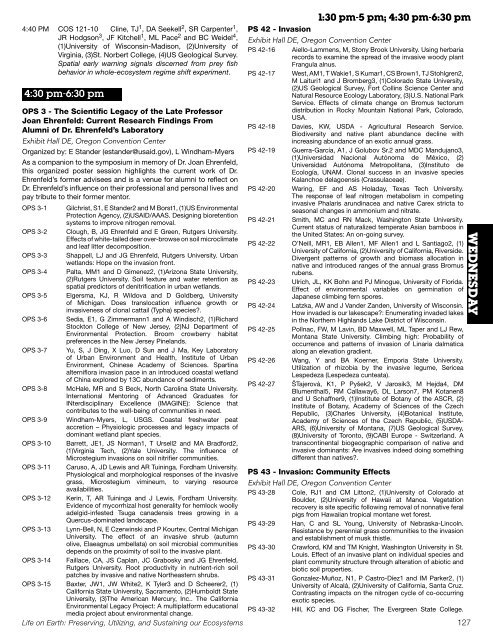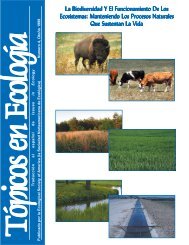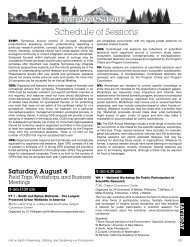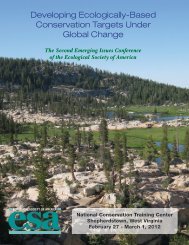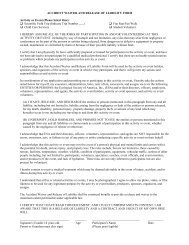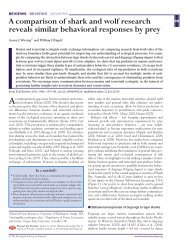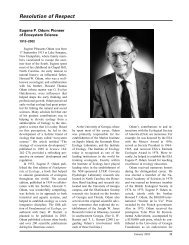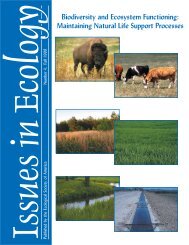Printed Program (PDF) - Ecological Society of America
Printed Program (PDF) - Ecological Society of America
Printed Program (PDF) - Ecological Society of America
Create successful ePaper yourself
Turn your PDF publications into a flip-book with our unique Google optimized e-Paper software.
4:40 PM COS 121-10 Cline, TJ 1 , DA Seekell 2 , SR Carpenter 1 ,<br />
JR Hodgson 3 , JF Kitchell 1 , ML Pace 2 and BC Weidel 4 ,<br />
(1)University <strong>of</strong> Wisconsin-Madison, (2)University <strong>of</strong><br />
Virginia, (3)St. Norbert College, (4)US Geological Survey.<br />
Spatial early warning signals discerned from prey fish<br />
behavior in whole-ecosystem regime shift experiment.<br />
4:30 pm-6:30 pm<br />
OPS 3 - The Scientific Legacy <strong>of</strong> the Late Pr<strong>of</strong>essor<br />
Joan Ehrenfeld: Current Research Findings From<br />
Alumni <strong>of</strong> Dr. Ehrenfeld’s Laboratory<br />
Exhibit Hall DE, Oregon Convention Center<br />
Organized by: E Stander (estander@usaid.gov), L Windham-Myers<br />
As a companion to the symposium in memory <strong>of</strong> Dr. Joan Ehrenfeld,<br />
this organized poster session highlights the current work <strong>of</strong> Dr.<br />
Ehrenfeld’s former advisees and is a venue for alumni to reflect on<br />
Dr. Ehrenfeld’s influence on their pr<strong>of</strong>essional and personal lives and<br />
pay tribute to their former mentor.<br />
OPS 3-1 Gilchrist, S1, E Stander2 and M Borst1, (1)US Environmental<br />
Protection Agency, (2)USAID/AAAS. Designing bioretention<br />
systems to improve nitrogen removal.<br />
OPS 3-2 Clough, B, JG Ehrenfeld and E Green, Rutgers University.<br />
Effects <strong>of</strong> white-tailed deer over-browse on soil microclimate<br />
and leaf litter decomposition.<br />
OPS 3-3 Shappell, LJ and JG Ehrenfeld, Rutgers University. Urban<br />
wetlands: Hope on the invasion front.<br />
OPS 3-4 Palta, MM1 and D Gimenez2, (1)Arizona State University,<br />
(2)Rutgers University. Soil texture and water retention as<br />
spatial predictors <strong>of</strong> denitrification in urban wetlands.<br />
OPS 3-5 Elgersma, KJ, R Wildova and D Goldberg, University<br />
<strong>of</strong> Michigan. Does translocation influence growth or<br />
invasiveness <strong>of</strong> clonal cattail (Typha) species?.<br />
OPS 3-6 Sedia, E1, G Zimmermann1 and A Windisch2, (1)Richard<br />
Stockton College <strong>of</strong> New Jersey, (2)NJ Department <strong>of</strong><br />
Environmental Protection. Broom crowberry habitat<br />
OPS 3-7<br />
preferences in the New Jersey Pinelands.<br />
Yu, S, J Ding, X Luo, D Sun and J Ma, Key Laboratory<br />
<strong>of</strong> Urban Environment and Health, Institute <strong>of</strong> Urban<br />
Environment, Chinese Academy <strong>of</strong> Sciences. Spartina<br />
alterniflora invasion pace in an introduced coastal wetland<br />
<strong>of</strong> China explored by 13C abundance <strong>of</strong> sediments.<br />
OPS 3-8 McHale, MR and S Beck, North Carolina State University.<br />
International Mentoring <strong>of</strong> Advanced Graduates for<br />
INterdisciplinary Excellence (IMAGINE): Science that<br />
OPS 3-9<br />
contributes to the well-being <strong>of</strong> communities in need.<br />
Windham-Myers, L, USGS. Coastal freshwater peat<br />
accretion – Physiologic processes and legacy impacts <strong>of</strong><br />
dominant wetland plant species.<br />
OPS 3-10 Barrett, JE1, JS Norman1, T Ursell2 and MA Bradford2,<br />
(1)Virginia Tech, (2)Yale University. The influence <strong>of</strong><br />
Microstegium invasions on soil nitrifier communities.<br />
OPS 3-11 Caruso, A, JD Lewis and AR Tuininga, Fordham University.<br />
Physiological and morphological responses <strong>of</strong> the invasive<br />
grass, Microstegium vimineum, to varying resource<br />
availabilities.<br />
OPS 3-12 Kerin, T, AR Tuininga and J Lewis, Fordham University.<br />
Evidence <strong>of</strong> mycorrhizal host generality for hemlock woolly<br />
adelgid-infested Tsuga canadensis trees growing in a<br />
Quercus-dominated landscape.<br />
OPS 3-13 Lynn-Bell, N, E Czerwinski and P Kourtev, Central Michigan<br />
University. The effect <strong>of</strong> an invasive shrub (autumn<br />
olive, Elaeagnus umbellata) on soil microbial communities<br />
depends on the proximity <strong>of</strong> soil to the invasive plant.<br />
OPS 3-14 Faillace, CA, JS Caplan, JC Grabosky and JG Ehrenfeld,<br />
Rutgers University. Root productivity in nutrient-rich soil<br />
patches by invasive and native Northeastern shrubs.<br />
OPS 3-15 Baxter, JW1, JW White2, K Tyler3 and D Scheerer2, (1)<br />
California State University, Sacramento, (2)Humboldt State<br />
University, (3)The <strong>America</strong>n Mercury, Inc.. The California<br />
Environmental Legacy Project: A multiplatform educational<br />
media project about environmental change.<br />
Life on Earth: Preserving, Utilizing, and Sustaining our Ecosystems<br />
1:30 pm-5 pm; 4:30 pm-6:30 pm<br />
PS 42 - Invasion<br />
Exhibit Hall DE, Oregon Convention Center<br />
PS 42-16 Aiello-Lammens, M, Stony Brook University. Using herbaria<br />
records to examine the spread <strong>of</strong> the invasive woody plant<br />
Frangula alnus.<br />
PS 42-17 West, AM1, T Wakie1, S Kumar1, CS Brown1, TJ Stohlgren2,<br />
M Laituri1 and J Bromberg3, (1)Colorado State University,<br />
(2)US Geological Survey, Fort Collins Science Center and<br />
Natural Resource Ecology Laboratory, (3)U.S. National Park<br />
Service. Effects <strong>of</strong> climate change on Bromus tectorum<br />
distribution in Rocky Mountain National Park, Colorado,<br />
USA.<br />
PS 42-18 Davies, KW, USDA - Agricultural Research Service.<br />
Biodiversity and native plant abundance decline with<br />
increasing abundance <strong>of</strong> an exotic annual grass.<br />
PS 42-19 Guerra-García, A1, J Golubov Sr.2 and MDC Mandujano3,<br />
(1)Universidad Nacional Autónoma de México, (2)<br />
Universidad Autónoma Metropolitana, (3)Instituto de<br />
Ecología, UNAM. Clonal success in an invasive species<br />
Kalanchoe delagoensis (Crassulaceae).<br />
PS 42-20 Waring, EF and AS Holaday, Texas Tech University.<br />
The response <strong>of</strong> leaf nitrogen metabolism in competing<br />
invasive Phalaris arundinacea and native Carex stricta to<br />
seasonal changes in ammonium and nitrate.<br />
PS 42-21 Smith, MC and RN Mack, Washington State University.<br />
Current status <strong>of</strong> naturalized temperate Asian bamboos in<br />
the United States: An on-going survey.<br />
PS 42-22 O’Neill, MR1, EB Allen1, MF Allen1 and L Santiago2, (1)<br />
University <strong>of</strong> California, (2)University <strong>of</strong> California, Riverside.<br />
Divergent patterns <strong>of</strong> growth and biomass allocation in<br />
native and introduced ranges <strong>of</strong> the annual grass Bromus<br />
rubens.<br />
PS 42-23 Ulrich, JL, KK Bohn and PJ Minogue, University <strong>of</strong> Florida.<br />
Effect <strong>of</strong> environmental variables on germination <strong>of</strong><br />
Japanese climbing fern spores.<br />
PS 42-24 Latzka, AW and J Vander Zanden, University <strong>of</strong> Wisconsin.<br />
How invaded is our lakescape?: Enumerating invaded lakes<br />
in the Northern Highlands Lake District <strong>of</strong> Wisconsin.<br />
PS 42-25 Pollnac, FW, M Lavin, BD Maxwell, ML Taper and LJ Rew,<br />
Montana State University. Climbing high: Probability <strong>of</strong><br />
occurrence and patterns <strong>of</strong> invasion <strong>of</strong> Linaria dalmatica<br />
along an elevation gradient.<br />
PS 42-26 Wang, Y and BA Koerner, Emporia State University.<br />
Utilization <strong>of</strong> rhizobia by the invasive legume, Sericea<br />
Lespedeza (Lespedeza cunteata).<br />
PS 42-27 ŠTajerová, K1, P Pyšek2, V Jarosik3, M Hejda4, DM<br />
Blumenthal5, RM Callaway6, DL Larson7, PM Kotanen8<br />
and U Schaffner9, (1)Institute <strong>of</strong> Botany <strong>of</strong> the ASCR, (2)<br />
Institute <strong>of</strong> Botany, Academy <strong>of</strong> Sciences <strong>of</strong> the Czech<br />
Republic, (3)Charles University, (4)Botanical Institute,<br />
Academy <strong>of</strong> Sciences <strong>of</strong> the Czech Republic, (5)USDA-<br />
ARS, (6)University <strong>of</strong> Montana, (7)US Geological Survey,<br />
(8)University <strong>of</strong> Toronto, (9)CABI Europe - Switzerland. A<br />
transcontinental biogeographic comparison <strong>of</strong> native and<br />
invasive dominants: Are invasives indeed doing something<br />
different than natives?.<br />
PS 43 - Invasion: Community Effects<br />
Exhibit Hall DE, Oregon Convention Center<br />
PS 43-28 Cole, RJ1 and CM Litton2, (1)University <strong>of</strong> Colorado at<br />
Boulder, (2)University <strong>of</strong> Hawaii at Manoa. Vegetation<br />
recovery is site specific following removal <strong>of</strong> nonnative feral<br />
pigs from Hawaiian tropical montane wet forest.<br />
PS 43-29 Han, C and SL Young, University <strong>of</strong> Nebraska-Lincoln.<br />
Resistance by perennial grass communities to the invasion<br />
and establishment <strong>of</strong> musk thistle.<br />
PS 43-30 Crawford, KM and TM Knight, Washington University in St.<br />
Louis. Effect <strong>of</strong> an invasive plant on individual species and<br />
plant community structure through alteration <strong>of</strong> abiotic and<br />
biotic soil properties.<br />
PS 43-31 Gonzalez-Muñoz, N1, P Castro-Díez1 and IM Parker2, (1)<br />
University <strong>of</strong> Alcalá, (2)University <strong>of</strong> California, Santa Cruz.<br />
Contrasting impacts on the nitrogen cycle <strong>of</strong> co-occurring<br />
exotic species.<br />
PS 43-32 Hill, KC and DG Fischer, The Evergreen State College.<br />
127<br />
WEDNESDAY


